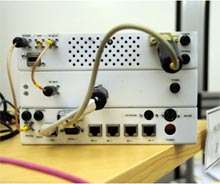August 20, 2009 weblog
New Wi-Fi Technology Using White Spaces

(PhysOrg.com) -- A wireless internet network that uses portions of the old analog TV spectrum may one day become a reality. The plans for a computer network that uses "white spaces," which are empty fragments of the old analog TV spectrum scattered between used frequencies, will be presented at the ACM SIGCOMM 2009, a communications conference held in Barcelona, Spain.
Prior to the analog-to-digital TV conversion, earlier this year, TV stations broadcast over lower frequencies to carry the signal longer distances. With the ongoing transition from analog to digital broadcasts, more unused frequencies are opening up. By utilizing these lower frequencies it would now be possible to provide broadband Internet access in rural areas thereby completing their Wi-Fi network.
The spectrum between 512 megahertz and 698 megahertz that was originally used for analog TV channels 21 to 51, offers a longer range than conventional Wi-Fi, networks that operate at 2.4 gigahertz.
In November of 2008 the FCC ruled that companies could transmit over white spaces but also gave them strict requirements that they must not interfere with existing broadcasts, both from TV stations and from other wireless devices that operate within the same spectrum.
Microsoft researchers are testing a new protocol, called White Fi, in their Redmond campus that uses UHF white spaces. The protocol would adaptively configure itself to operate in the most efficient part of the available white spaces.
A White Spaces Coalition group has been formed which consists of eight large technology companies that plan to deliver high speed broadband internet access in unused television frequencies between 54-698 MHz. The coalition expects speeds of 80 Mbps and above, and 400 to 800 Mbps for white space short-range networking.
Via: Dailywireless & Technology Review
© 2009 PhysOrg.com















